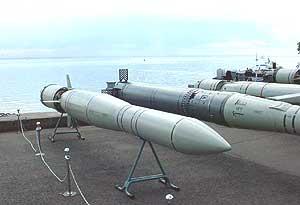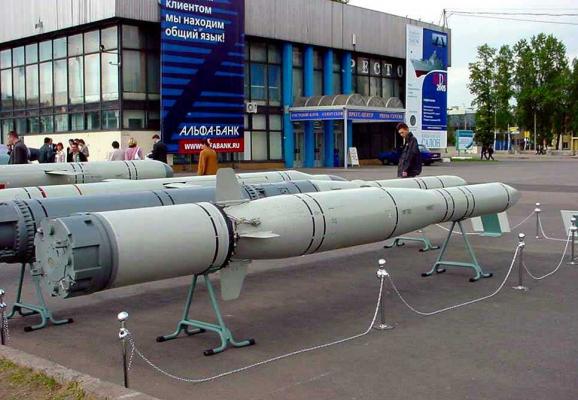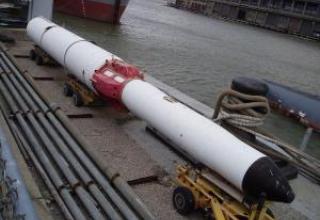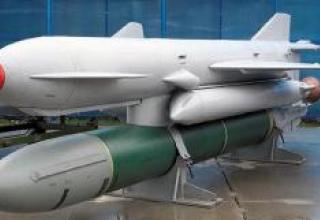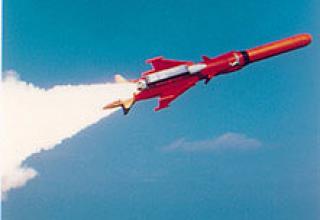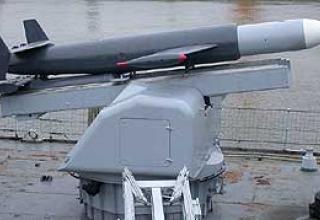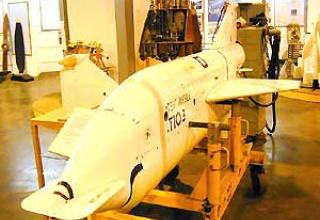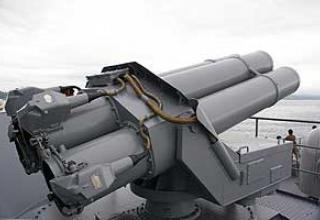The 91PE1 and 91PE2 anti-submarine missiles are designed to engage modern and advanced submarines (including multi-purpose nuclear missiles) in submarine, periscope and surface positions in any waters of the World Ocean, including areas with shallow depths.
The 91PE1 and 91PE2 missiles were developed at the Novator Design Bureau, OJSC (Ekaterinburg) on the basis of the 86P Vodopad antisubmarine complex.
The 91RE1 missile is part of the Caliber-PLE integrated missile system for arming submarines (export designation "Club-S") and the 91RE2 missile is part of the Caliber-NKE integrated missile system for arming surface ships (export designation "Club-N"). The Calibre-PLE and Calibre-NKE systems are designed to engage ground, sea and underwater targets under conditions of intensive fire and electronic countermeasures.
The Caliber-NKE and Caliber-PLE rocket systems are part of the missile systems:
- combat vehicles:
- a universal control system (SU) for a missile system,
- launchers,
- loading facility kit.
- universal ground equipment complex.
Rockets of the "Caliber-PLE" complex are launched from regular torpedo vehicles of 533 mm caliber submarine, and the "Caliber-NKE" complex - from sub-deck unified vertical PU 3C-14E or deck inclined SS-14PE. Availability in the systems of missiles for various purposes, as well as a single universal shipborne part allows to vary the range of carrier rockets depending on the task in view and the specific combat situation.
India became the first foreign customer of Club-N missile system. The complex is installed on frigates of project 11356 built by Indian Navy at the Baltic Plant (St. Petersburg) (Talwar type - see photo). On July 19, 2000 at the "Admiralty Shipyards" plant (Saint-Petersburg) the DPL of project 877EKM built for the Indian Navy was launched, where Club-S weapon complex was installed. On the other boats purchased by India earlier, Club-S is being installed as part of the repair and modernization work carried out at Zvezdochka (Severodvinsk) and Admiralty Shipyards.
The "Calibre-NKE" complex is part of the armament of project 21956 squadron destroyers developed by the Northern Design Bureau (St. Petersburg).
The designation of this system according to US/NATO classification is SS-N-27 "Sizzler".
Composition:
The general principle of operation of both types of missiles provides for their launch into the area of location of the detected underwater target according to the target designation data from external sources, previously entered into the onboard control system. As a means of destruction of 91PE1 and 91PE2 missiles the high-speed anti-submarine missile APR-3ME or self-guided small-size torpedo MPT-1UME (weight-300 kg, diameter-324 mm, length-3000 mm, mass BC-60 kg) is used. APR-3ME and MPT-1UME belong to the third generation of anti-submarine weapons and provide for independent search and detection of an underwater target in silent mode, high-speed approach to it and defeat before the beginning of evasive and counter-measures maneuvers.
The 91PE1 ballistic missile (see layout chart) of the "submarine - submarine" class is launched from 533 mm torpedo tubes from a diving depth of 20 to 150 m at a submarine speed of up to 15 knots into the area where the detected submarine target is located. The range of fire at launch from a depth of 20 to 50 m is 5-50 km, and at launch from a depth of 150 m - 5-35 km. Up to four missiles can be volley launched on one target. The prelaunch preparation time is 10 seconds.
Solid fuel engine of the first stage 91PE1 provides its movement on the underwater section of the trajectory, exit from the water and the altitude gain. The RDTT is then separated and the second stage flies along a controlled trajectory into the target area. When flying in the airborne section of the trajectory, the onboard inertial control system provides stabilization and guidance of the missile to the specified aiming point.
The 91PE2 anti-submarine missile (see layout chart) is designed to arm surface ships equipped with 3C-14E or 3C-14PE unified launchers. The 91PE2 is launched at any speed of the carrier ship. The 91PE2 missile's launch engine is less powerful than that of the 91PE1 missile, it provides the missile's exit from the ship's launcher and its altitude gain. At the design point, the second stage is separated, which is driven by parachute and then searched and pointed at a submarine target (see application chart). The firing range is 40 km. The pre-start preparation time is 10 seconds.
Prelaunch preparation of 91PE2 missiles, formation and commissioning of the flight task is carried out by a universal control system (SU) missile system 3R-14N. It is an automated system that operates in real time as part of the carrier ship's combat information and control system (BIUS). The Demand-M BIOS developed by JSC NPF Meridian is installed on project 11356 ships.
Require-M" BIS is an open distributed adaptive computing system. Conjugation of the rocket complex with BIUS is carried out through the digital channel of a local network by means of special devices of conjugation. According to the target designation and commands from the BIOS "Requirement-M" and the navigation system of the carrier ship of the rocket system SU produces data for firing, manages the prelaunch preparation and launch of missiles for various purposes from the complex, as well as routine inspection of systems and missiles. Information on the status of the missile system, the availability of ammunition, plans for its use, control commands are transmitted in graphical and tabular form to the automated workstations (AWS) BIUS "Require-M". This ensures centralised control of all the ship's weapon systems with a view to their optimal use for various combat tasks, including control of the ship's combat operations against submarines and the use of anti-submarine weapons. All instruments in the missile system's control system (except for the missile weapon control console) are unmanned, maintenance-free, spray and waterproof. The equipment is fire- and explosion-proof and does not require cooling during operation.
Regulatory maintenance of missiles in the process of storage at the base and their preparation for loading on the carriers provides a universal complex of ground equipment from the complex.
Characteristics:
| 91PE1 | 91PTE2 | |
| Caliber, mm | 533 | 533 |
| Length, mm | 7650 | 6200 |
| Starter weight, kg | 2100 | 1200 |
| Depth of start, m | 20-150 | - |
| Range of fire, km | 5-50 (from a depth of 20-50 m) 5-35 (from a depth of 150 m) |
40 |
| Number of rockets in a volley for one target | up to 4 | up to 4 |
| Maximum flight speed on the march (ballistic) section, M | 2,5 | 2 |
| Pre-start preparation time, s | 10 | 10 |
Testing:
In the mid-1960s, in order to study the impact of aggressive propellant components on the missile during its long-term operation, on the initiative of V.N.Chelomey at the test base in Faustovo were built two mine launchers for missiles 8K84. One of the silos was manufactured in the standard version and was intended for research of the standard missile during the entire warranty period of its storage. This mine also contained more than 1000 samples of materials - metals, non-metals, rubber goods, adhesive and welded joints of various shapes and combinations, radio equipment, pumps, batteries and much more. In addition to the employees of OKB-52 more than 100 related enterprises participated in the research of materials resistance to long-term storage. Simultaneously, several times a day for the duration of many years of storage about 100 parameters (temperature, humidity, gas content, pressure in tanks, etc.) were registered. The second mine was also designed for the 8K84 missile. The rocket installed in it was filled with aggressive components and stored at a temperature of + 50 degrees for accelerated corrosion tests within one year. During the experiments, no serious malfunctions or failures of rocket systems were detected in any of the mines. The results of these tests extended the warranty period for subsequent modifications to 15 years, then to 20 years, then to 25 years.
Sources:
- Энциклопедия "Оружие и технологии России". 2001г.
- Волковский Н.Л. энциклопедия современного оружия,1997г.
- Перспективы развития БИУС для кораблей малого и среднего водоизмещения на базе системы "Требование-М" /Морская радиоэлектроника/
- «Клаб» (Club), ракетная система
- Talwar {Krivak III} Class /www.bharat-rakshak.com/
